Last Updated on February 15, 2021 by
I have lived in Vadodara for decades before living in Ahmedabad and yet I never knew about the places to visit in Vadodara. Over the past few years, my visit to Vadodara is limited to the weekend which is spent relaxing or relishing the street food in Vadodara. But during my recent visit, I decided to spend more time to explore the city which I call my hometown. Tambekar Wada is the first place I explored and was totally blown over by it which made me write a dedicated post for it.
I rode my motorbike to reach the Tambekar Wada, located in the Tambekar no Khancho, Raopura following the google instructions. I stopped exactly where it said ‘You have reached your destination. Your destination is on your left’, and it did not look the way I had looked up on google. The building looked like a government office so I went in to find out. I asked 3 different people about a building with wall paintings and nobody had a clue as to if I was asking them in, French! All of them kept saying that I am in Tambekar Wada but part of it is a ward office and part of it is a school. I checked and rechecked on google, and it said I am in Tambekar Wada.
I was flabbergasted and clueless about what my next move should be!
I had noticed a temple just before entering this government building and I hoped I would find someone who will guide me! The doors were closed (What has Covid-19 done to religious places!!) but luckily, I saw someone in a house and I asked him about Tambekar Wada paintings and he said well you are in Tambekar Wada only. This was it and I decided to give up!!
Then he added if you want to see the paintings, go around the main road and you will find what you are looking for!
I walked around and finally saw ‘Archeological Survey of India’ board, which meant I was finally in the right place.
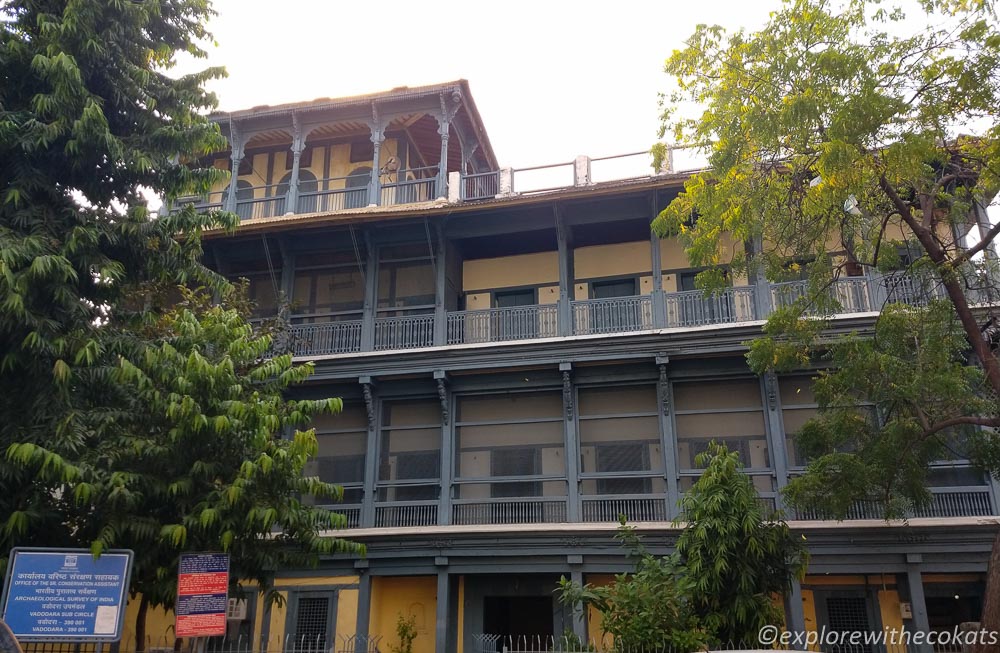
Table of Contents
What is Wada?
Wada is a courtyard style housing which was predominant in entire India during yesteryears. Wada was designed to suit the Indian weather as well as the joint family set-up which was part of the Indian tradition. Wada was designed and made using locally sourced materials and with a heavy influence of the local architecture.
A typical Wada consists of an all-encompassing massive structure that could accommodate a cluster of houses with a central courtyard, forming the focus of the household’s social activities. In Pune, the Wada was as big as a fort and housed an entire community.
Wada style housing is still found in many parts of Maharashtra and Gujarat (earlier Bombay Presidency). Though most of them are in shambles, the Wadas of Pune have been protected under ASI and are a must-visit, especially if you like culture, architecture and art.
About Tambekar Wada
As I walked inside the Tambekar Wada, I could not help but notice the typical Maratha style 3-storeyed building with garden space. It was formerly the residence of Diwan of Baroda State – Vithal Khanderao Tambekar, fondly known as Bhau Tambekar. The house is divided into two main parts with a courtyard in the middle. The front portion of the house has paintings on the walls and ceilings – to entertain and host guests. While the back potion was the residence and does not have any frescos.
The interior of the Wada is nothing but a riot of colours. Paintings, frescos and murals decorate the walls, doors, and ceiling. Each inch in the Wada is painted depicting characters and stories from Indian mythology – Mahabharata, discussions with the Britishers, festivals, culture, war scenes, fight sequence and so much more!
Tambekar Wada reflects the exquisite craftsmanship of its time and features some characteristic paintings which are quintessential to the bygone era.
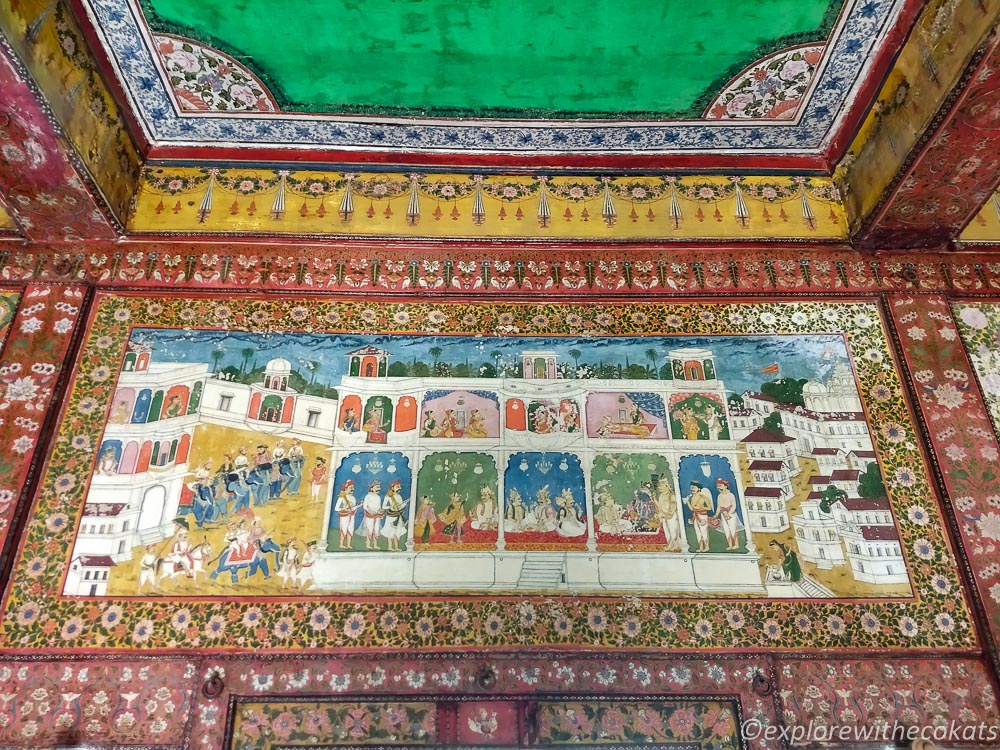
Exploring the frescos of Tambekar Wada
As I entered the ground floor area, I was given a hand sanitizer and asked to write my name and contact number in a register. This area is turned into an ASI office so visitors are not allowed to see this space.
There are no entry fees to Tambekar Wada.
An attendant then asked me to follow him to the first floor where he would show me the frescos. Before I took the first step, he advised me to be careful as the steps are very steep and encouraged me to use the installed rope as a handrail.
As I reached the first floor, which was dimly lit with natural light on one side, I could see some frescos in good condition and somewhere the ceiling plaster has come off due to weathering. I was overwhelmed to see the details of painting on every inch of the second floor – including door frames. It took me time to settle and focus on one painting and try to make sense of what it wanted to portray.
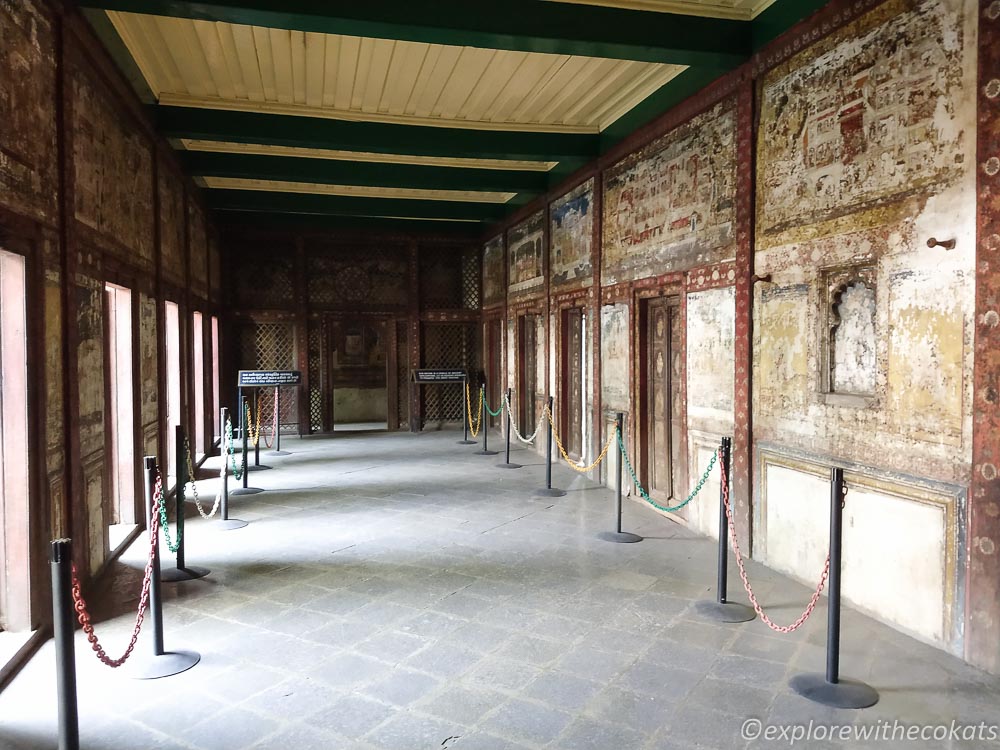
I asked the attendant about the paintings but he did not have much information. Unfortunately, there are no information panels for the painting, and you have to try and make sense of yourself. The paintings were made in the 1870s and the technique used is Secco.
At the end of this room, there is a wooden jaali – hand made with precision that it is difficult to understand how it was made in that time. The frescos behind this jaali are mind-blowing! There are narrow balconies on both sides – one which gives a view of the main road and another one of the courtyard.
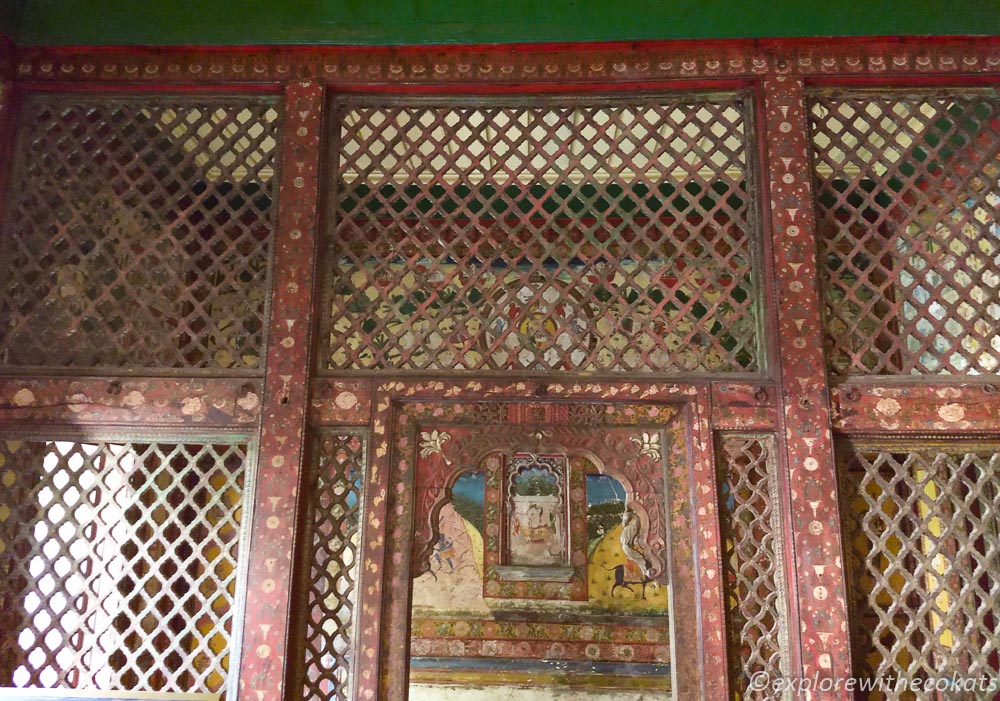
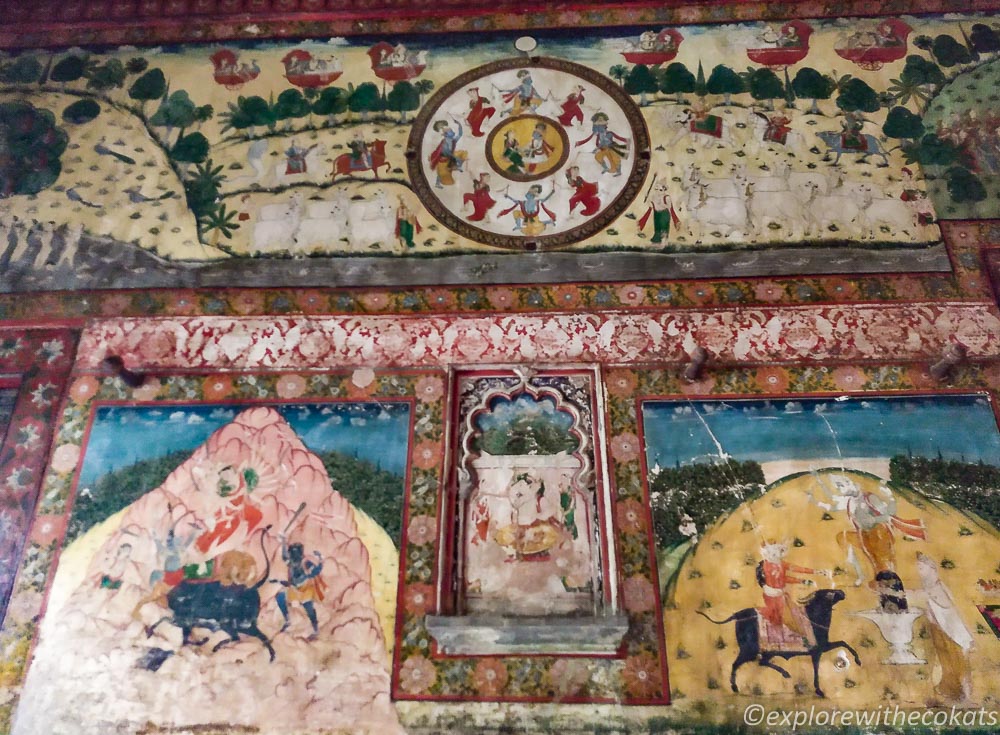
I climbed even steeper steps to reach the second floor. The initial hall did not have any remnant of the frescos and it looked like it was whitewashed with yellow colour. But it is only due to no preservation and weathering that the frescos have disappeared. Thankfully we crossed that hall into another room which had the masterpieces in relatively good condition.
Krishna on the throne
Krishna is seated on a throne with the mor mukut like those in Vrindavan. He is attended by his consort shown as a cowry bearer is shown like a Gujarati woman; he is shown surrounded by the assembly of gods, worshipped by maybe the local king. To the right of Krishna and between Shiva and Ganesha, Gauri is shown. Behind Ganesha are shown the Kala and Gora Bhiravs.
On the row below is probably the six-headed Karthikeya and behind Narada is probably Tumburu (without his horse face) behind has a ektara or tuntuna or tambura in hand.
The king resembles Raja Ramsingh of Kota. The god before the king has four hands with rose/ lotus in hands. Who is it, I know not, again no specific attributes presented. All gods except Trimurtis and sages are draped in cloaks and they all have only two hands. The face of the saints and the flora on top is for sure the signature of the artists of Nathadwara.
The image shows more Mughal influence on all the kings here than the so Marathi style.
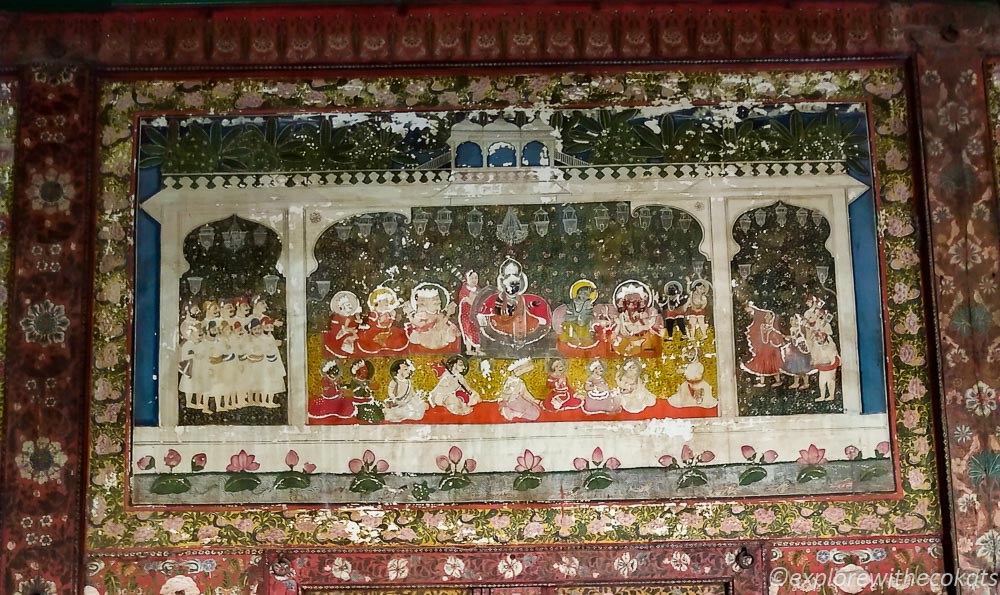
Flower Frescos
This shows some of the exotic flowers like a chrysanthemum. With the real flower bulbs, either not being available and/ or being prodigiously expensive, these were probably cheaper substitutes to please the Europeans who visited. The beautiful aphoristic pictures of flowers in crystal vases here were probably made for pure visual pleasure.
The slender stems in flocculent green, with a variety of blossoms, cornflowers, peonies, and anemones, in a multitude of colours are fascinating for the eyes. The parrot, bullfinch in the painting adds a giddy sense of floating among the bright petals, making the eye travel all over the image.
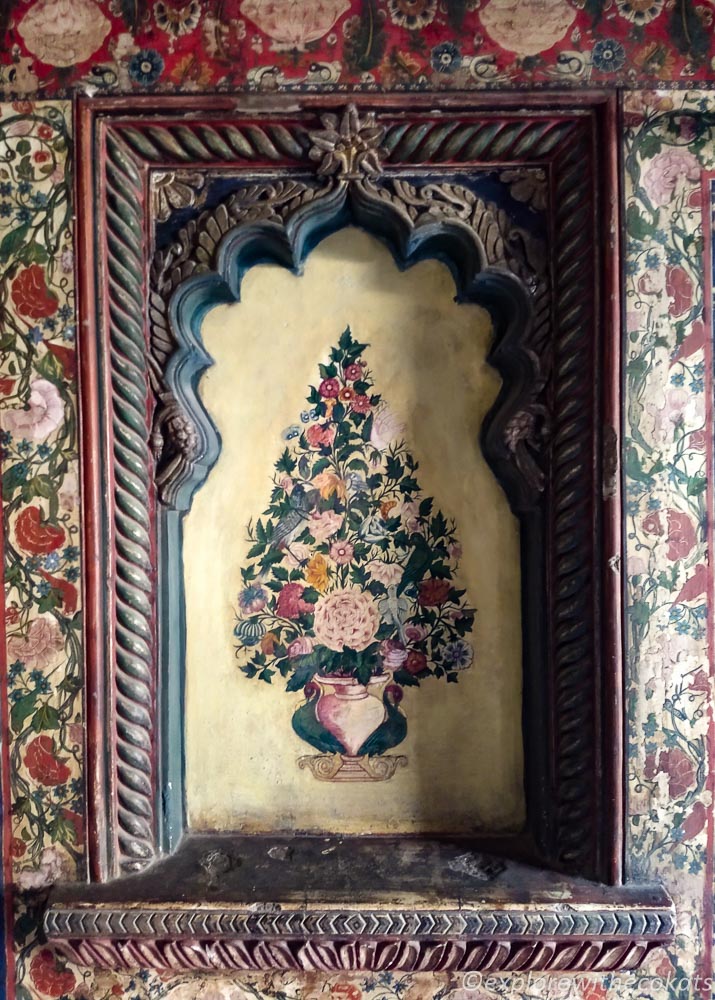
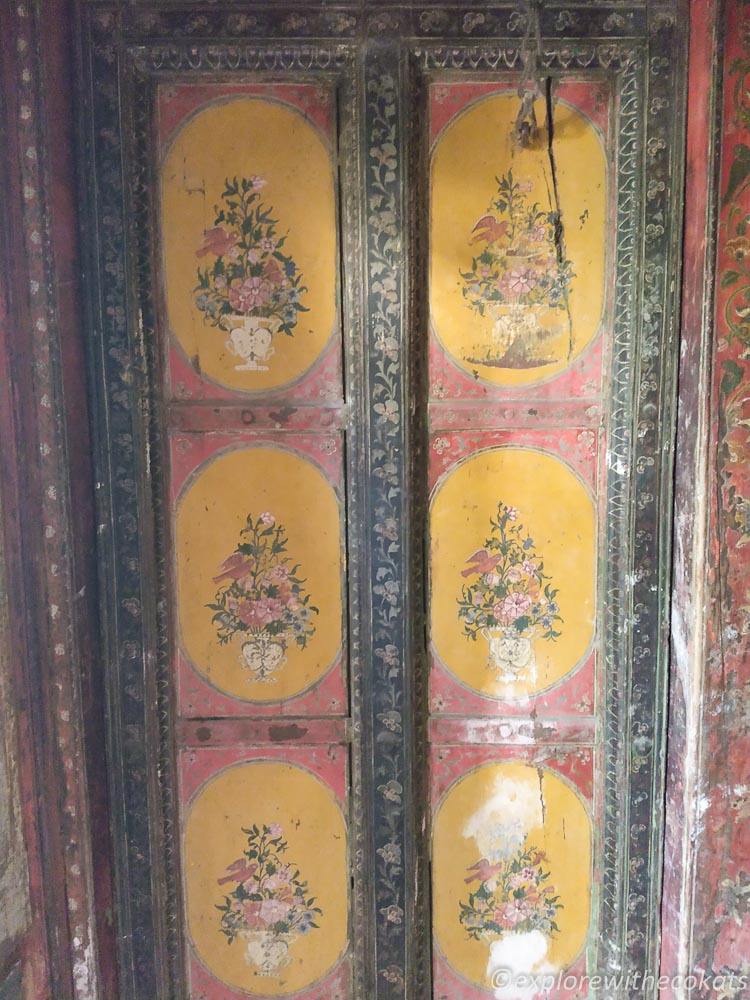
Murals from Indian mythology
There are murals which depict various scenes from Mahabharata including the anecdotes from the life of Krishna. There are ample contemporary scenes from the Anglo-Maratha wars of 19th CE. And there are many frescos depicting war scenes.
There is also a collage of paintings on the walls of Tambekar Wada. Some of the larger paintings are like scrolls telling a story in small scenes.
Apart from these four rooms spread on two floors, the rest of the Wada is in ruins. However, I was told that the Wada is going to be taken up under the Centre which will ensure its restoration.
Whether it happens or not, only time will tell. But before it crashes, add it to your Vadodara tourism list and make sure to visit.
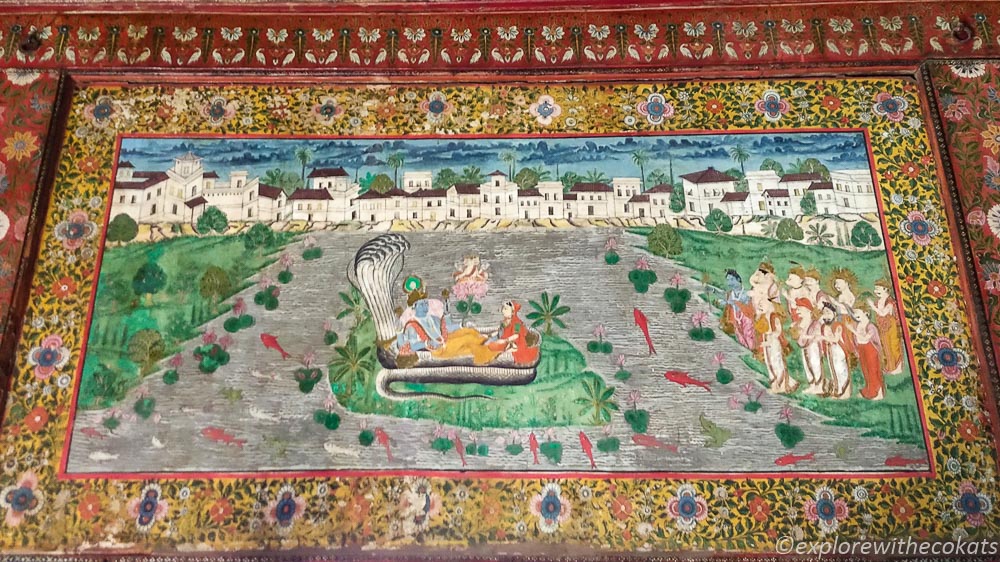
When to visit Tambekar Wada
Tambekar Wada is open from 10 am to 5 pm every day. Thankfully there were no other visitors when I went so I got the entire Wada to myself to explore and observe.
Is photography allowed in Tambekar Wada
Initially, the attendant did not allow me to take photos. But I requested the lady in the office on the ground floor, and I was allowed to take photos with a mobile phone (professional camera not allowed). Also, flash photography not allowed. Selfies or photos with the frescos are a strict no-no.
Places of interest near Tambekar Wada Vadodara
Lakshmi Vilas Palace
Kirti Stamb
Khanderao market
Kirti Mandir
Maharaja Fateh Singh Museum
Baroda Museum and Picture Gallery
Aurobindo Ashram
Navlakhi Stepwell
Sur Sagar Lake
Read a detailed guide on how you can cover all of the above-mentioned places: Things to do in Vadodara.
Sustainable travel tips for visiting Tambekar Wada
- Being an ancient property which is already dwindling with age, respect the frescos and wall by not touching/scratching them.
- Do not click pictures, if you are not allowed to.
- Do not try to enter the backside of the Wada as it is closed to visitors.
- Throw your garbage in the dustbins located at the entrance of each temple.
Travelling to Ahmedabad from Vadodara? Here is my 2 days Ahmedabad itinerary.
Disclaimer: This post contains affiliate links. Read my Privacy Policy to know more.
Pin this post!
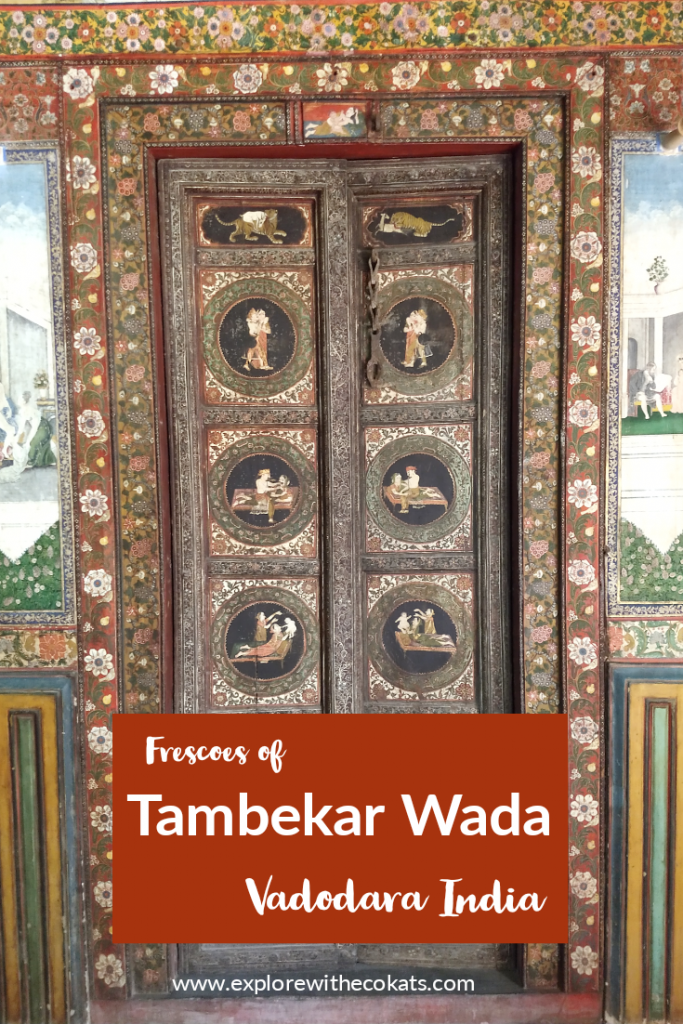
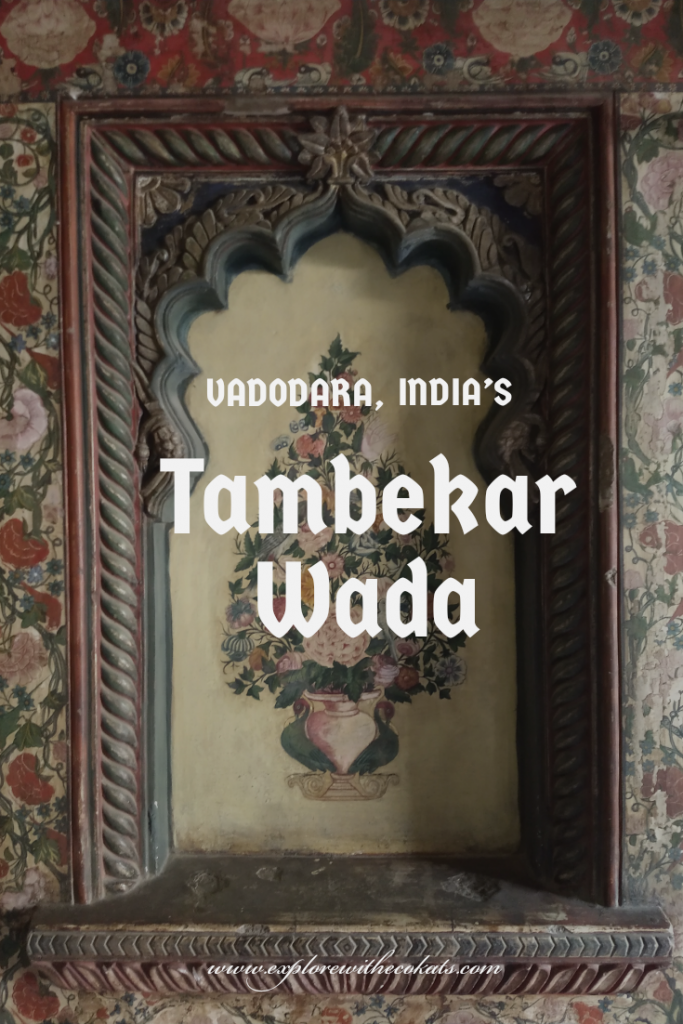

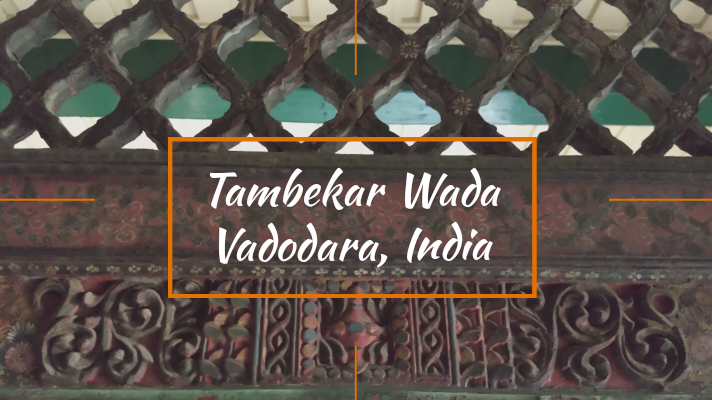
6 comments
Interesting place… glad you chose to write about it.. its bot the typical blog that features on a tourist itinerary.. thank you:)
Thank you. I am trying to showcase my hometown which was a revelation to myself too!
Backyard explorations are the best, because they lead us to places that are lesser known and less talked about. This looks such a well maintained Wada! Love the details of the frescoes, so colourful, so intricate! 🙂 Thank you Ketki for this post. Can’t wait to visit this when I come to Baroda next. and yes, a special mention for the doors! Exquisite they are.
Thank you Divyakshi. Unfortunately, a lot of frescos have disappeared over the years due to irregular maintenance. But I really hope that it is restored the way it is being claimed so that it comes back in its full glory. I hope you are able to visit 🙂
I love the Murals and colors in the Post. Love reading it. I haven’t visited yet but it’s on my list. Many People never heard about it.
I was stunned after visiting it. It is a must-visit for anyone coming to Baroda!